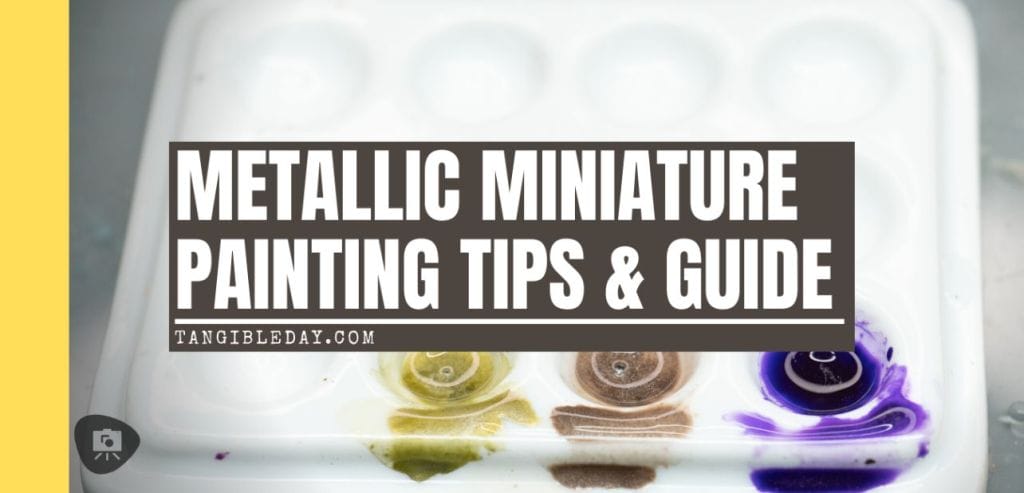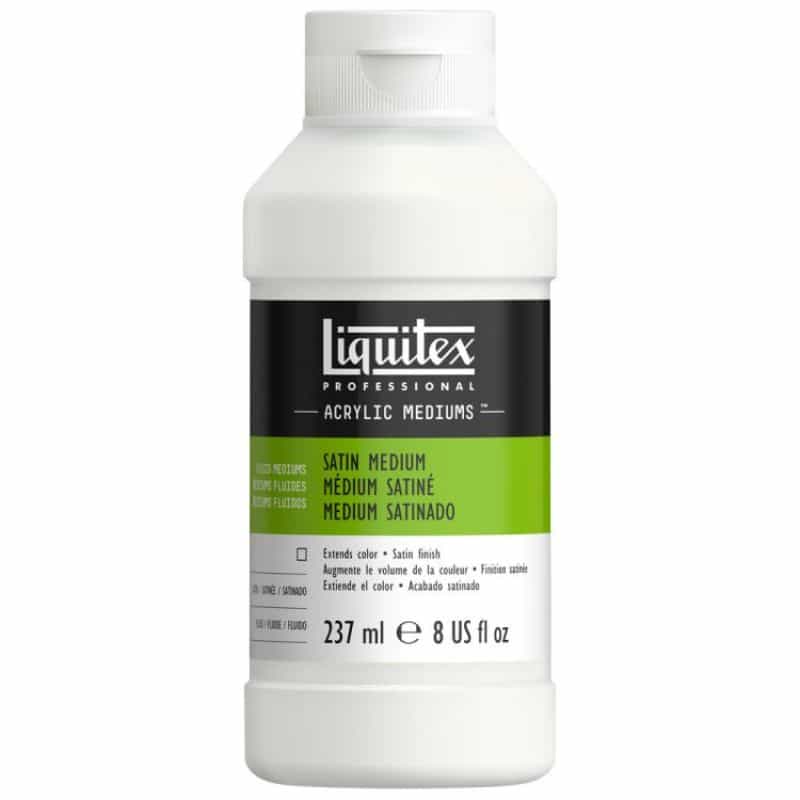Are you having trouble painting with your hobby metallic paints? Metallic paints are wonderful for adding a little accent or realism to your models and dioramas. But, they can be frustrating to work with. Luckily there are some simple things you can do that will help them go on smoothly and keep your sanity.
In this article, I share my experience with using acrylic metallic paints for painting miniatures and scale models. Here you’ll learn about some common difficulties with metallic paint and tips to ensure you are painting metallics to their best potential. If you’re painting with silver, bronze, steel, gold, or any of the popular metallic paint colors, tones, and hues, check out the tips below that help you get the best results you’re after.
RELATED: BEST METALLIC PAINTS FOR MINIATURES AND MODELS
Why Paint Miniatures with Acrylic Metal Paint?
Before we get started though I want to address something: Why should we use metallics in the first place? Don’t non-metallic alternatives look better, such as non-metallic metal (NMM) painting styles? The answer is both yes and no, depending on the situation. Sometimes non-metallic paints (i.e., regular acrylic colors) are preferable, but sometimes you really need a metallic paint for realism.
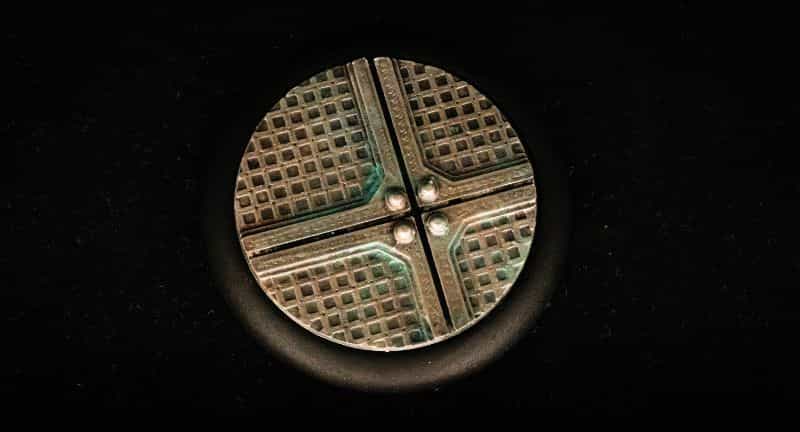
The reason is simple for why you should paint using metallic paints: Metallic paints are shiny. For a metallic effect, metallic paints provide the easiest route to that reflective finish. Non-metallic paints like the ones commonly used in the NMM painting technique are flat. They don’t reflect light like real metal does, they absorb it. This makes them look great for tabletop miniatures because they won’t catch reflections, which can reduce color vibrancy and contrast (which give models that 3D pop).

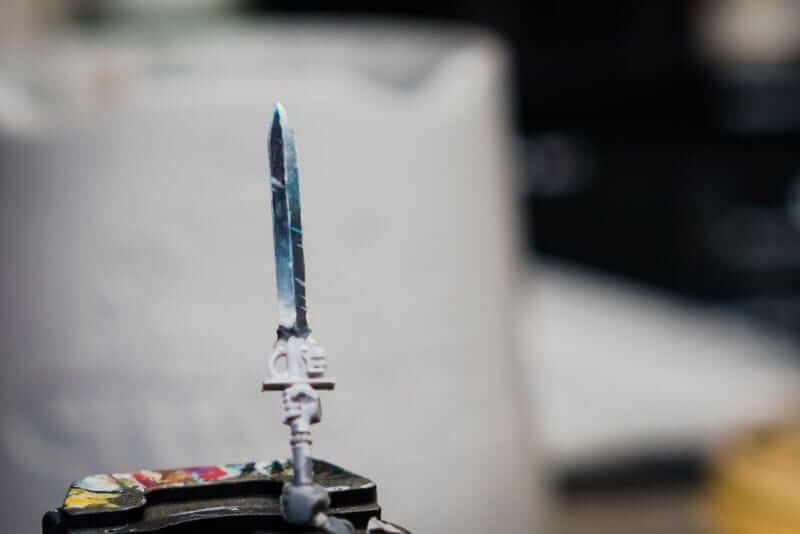
On the other hand, real metals in paint do reflect light and just looks better than flat paint in a lot of other situations. It is also much easier to paint metal surfaces on a miniature or model with metallic paints. And, as mentioned, I agree with many other painters that most paint jobs generally look much better when metallic paints are done well, than compared with a mediocre NMM paint job on miniatures.

Bottomline: A lot of people like to paint their miniatures and models with metallic paints.
Metallic paints can make your model stand out and look more realistic. They also give the model a nice shine that you might want for your army or display piece.
There are a few things you should know before jumping into this type of painting project. In this article, we’ll discuss what those tips are so that you can get started right away without any worries about using metallic acrylic paints on your miniatures and models.
What is Metallic Paint?
Metallic paints are paints made from tiny metal pieces creating shimmering, metallic effects. They can be the same color as metals (such as silver or copper) or mixed in a variety of other colors for a metal appearance.
The metal color on a painted miniatures is also a result of the environment, given that the metal surface will often reflect all sorts of ambient hues and tones. Armor plates, for example, may take on a greenish hue when near a tree, while a bluish or brown tone when near dirt or earthy surfaces.
To create paint from tiny metal particles (or metal flake), manufacturers use a variety of techniques, including adding pigments to standard paints, mixing metallic ingredients with clear coats or varnishes (such as car finishes), or by creating their own paints that rely on special properties.
Aside from the main metallic effect of these paints, some are intended for regular painting use, while others are made to be used on top of previously painted surfaces. These paints intended for application over already-painted models are often called pigment powders or flakes.
Painting Miniatures with Metallic Paints
As a miniature painter, you can use a variety of techniques with metallics. Using multiple coats with your metal paints is the first step toward great results, generally using a base coat, followed by a second layer, and additional coats to get a good finish. A metallic surface is also an opportunity for using a glaze or wash to add more contrast and interest to a model.
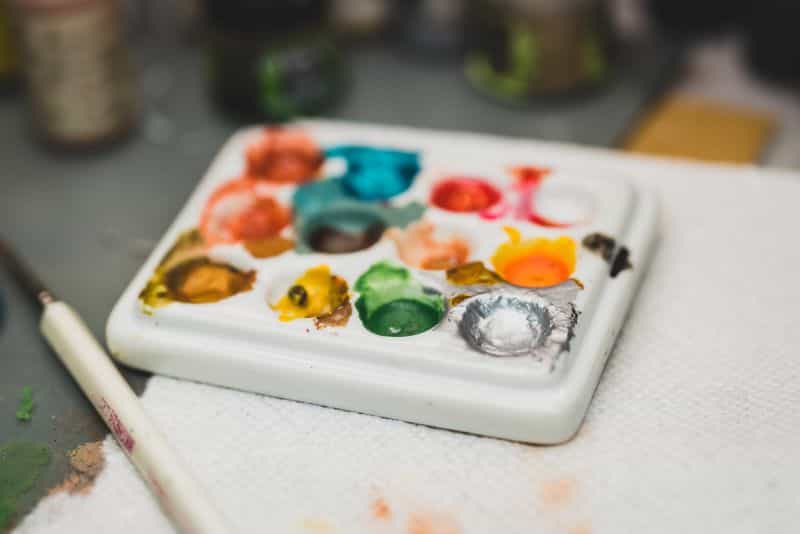
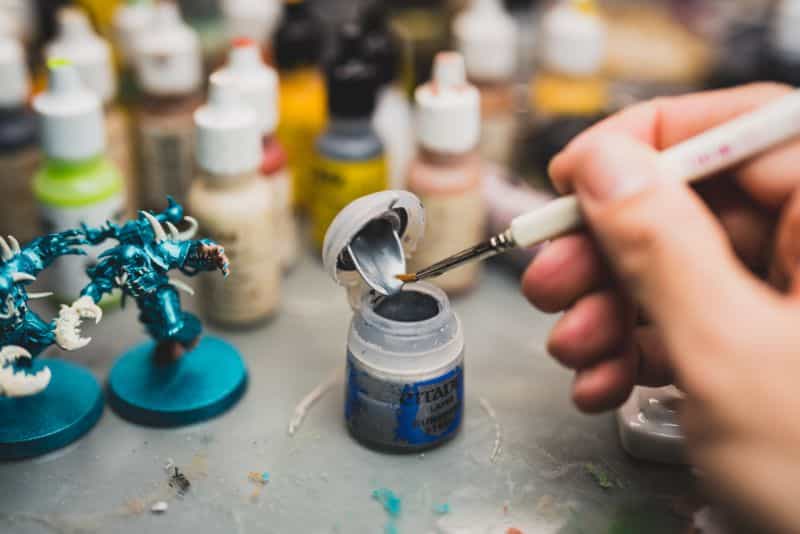
Miniature painting with metallics is more than simply coating your model in the paint itself. Miniature painters looking for a color scheme with a metallic look will often combine a lot of different colors together through glazes, shading, and understanding how the metal flakes within the paint itself appear from different angles.
For more in-depth tutorials on painting techniques, you can check out this miniature technique overview. For other lessons and tips for painting miniatures, there is always more to learn.
Why is it Bad to Thin Acrylic Metallic Paints?
There are several reasons why it’s bad to thin acrylic metallic paints for painting miniatures. When you thin the paint, it becomes more transparent and less opaque. This makes it difficult to cover the surface of the miniature with a consistent layer of paint, which can lead to an uneven finish. The paint can also be streaky and inconsistent if it’s not properly diluted. Most paints benefit from a smooth application with brush strokes in one direction.

When you thin acrylic metallic paints, they can also dry out and become unusable faster than if you didn’t thin them. Eventually, the paint will lose its color intensity as it dries out, even if you mix in several drops of water to refresh it. This is also a reason why I will not use a wet palette (if I can avoid them) when I’m painting with metallics.
Professional Tips: How to Avoid Problems When Using Acrylic Metallic Paints on Miniatures
- Use high quality, hobby-grade metallic paints (here is a review of my favorite metallics)
- Avoid thinning metallic paints, if possible
- Try to mix, not shake, bottles of metallic hobby paints–this prevents bubbles from forming inside the thicker paint medium
- Different brands of metallic paints may not be compatible
- Allow metallic paints to completely dry on a model before painting additional layers or applying other techniques
- A matte or satin varnish will hide flaws in metallic coats, but could also reduce the reflective qualities of the metal surface
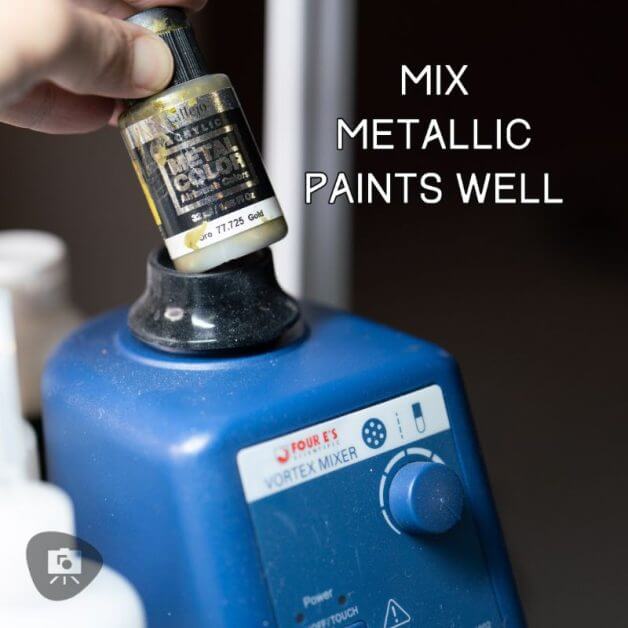
One way to prevent problems when using acrylic metallic paints on miniatures is to purchase high-quality paints that are already thinned for use on small surfaces. Avoiding the temptation to thin the paint yourself, even if it’s more convenient. This can save you time and hassle down the road.

Using too much paint at once instead of spreading it around the surface of the model with several touch-ups can also cause problems. Make sure you apply metallic paints in even layers. This takes practice if you’re trying to avoid thinning the paint. If you must thin the paint to help it flow, my suggestions is to dampen your brush in water, then dip it into the metallic paint–rather than thinning the metallic directly.
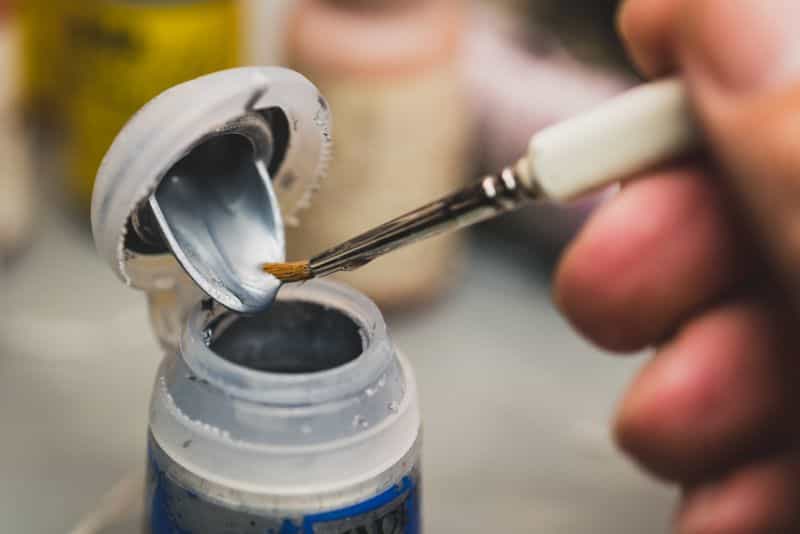
Always check whether paints are compatible before using them together, since some brands may contain ingredients that cause others to thicken or dry more quickly. For example, Reaper’s Master Series Paints don’t work well with Army Painter paints because they tend to thicken over time.

There are several other ways to prevent problems when using acrylic metallic paints on miniatures, including giving the paint plenty of time to dry before doing any extensive handling or repainting. You may also want avoid tabletop gaming for a few hours after applying metallic paints (or immediately varnish your surface), since the oils in your hands can mix with the paint and cause color changes. I found this latter to be true in some cheaper, arts & crafts brands.
If you find that you aren’t completely satisfied with a metallic paint after it dries on a model, adding some clear matte varnish to help seal in the paint can help prevent any problems. However, adding too much varnish can cause the metallic paint to lose its luster.
What Thinners Can You Use with Metallic Paints for Painting Scale Models and Miniatures?
You can use water or artist grade thinner medium, such as Liquitex Satin Medium, to lower the viscosity of metallic paints for painting scale models and miniatures. Avoid using anything that contains acetone or alcohol, since it can cause the paint to dry out more quickly.
I would also use caution when using flow aid, or flow improvers with metallic paints, as these can also disrupt the way the metal pigments settle and dry when you paint them. It won’t look good. To repeat, I do not recommend using flow improvers, soapy type thinners, e.g., surfactants, to thin acrylic metallic paints. They are more problematic than helpful.
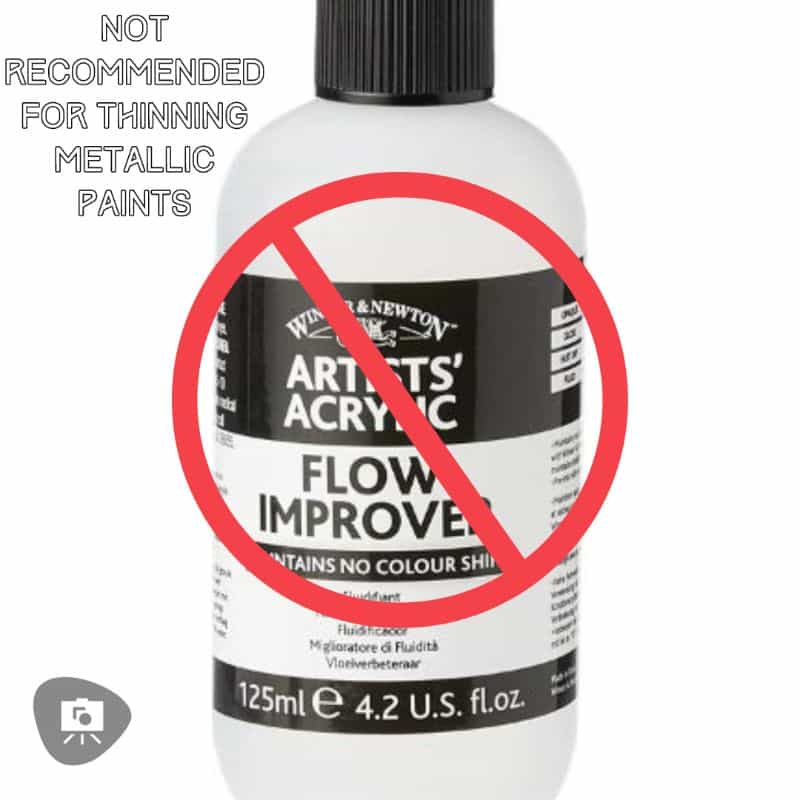
For best results, mix metallic paints with thinner medium in small amounts until you get a consistency that’s appropriate for your needs. If you need to thin out more than a dime-sized amount of metallic paint at a time, it may be easier and more cost-effective to use a small container with a cap so you can take your time.
How Do You Get Metallic Paints to Look Their Best on Miniatures?
For larger surfaces, you can get acrylic metallic paints to look their best on miniatures by using a brush with soft bristles dampened with water. This is a good method for preventing color changes and giving you more control over the application of metallic paint.
You can also use a soft-haired synthetic brush with a blunt tip, such as a round watercolor brush, to apply metallic paints on miniatures. What brush you use for using metallic paint will depend on the size of your model and the level of detail you’re trying to achieve.
The best results will come from layering thin layers of paint rather than applying one thick coat that covers up too much of the detail in your model. Obviously, you may need thinner, better flowing metallic paint to do this. So be careful with the brand you’re using, as well as what you add and mix to the metallic paint.
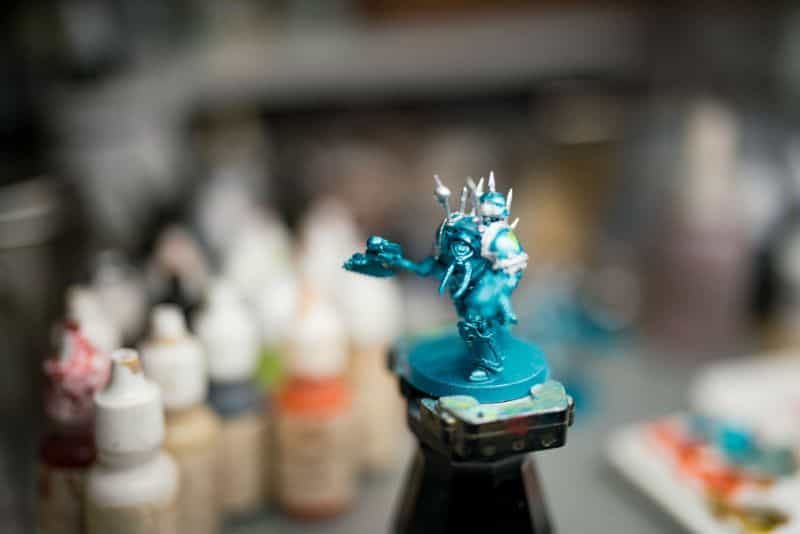

Can You Mix Inks with Metallic Paints to Change its Color?
Yes, this is a cool trick!
I know some people who use colored acrylic inks to change the color of their metallics. For example, if you add purple ink to a bright gold metallic, you may get a copper or bronze looking metallic.
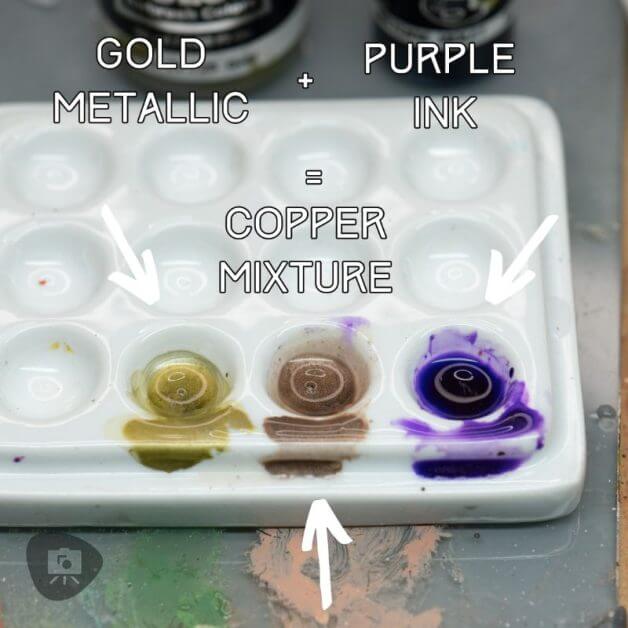
Acrylic inks are great because they are a low viscosity liquid pigment that can change the hue and tone of anything they are blended into without changing that solution’s ability to adhere to a surface. Try a blend of neutral metallic with blue or brown ink and see what you get! The results could be amazing!
What’s the Difference Between Acrylic Metallic Paints and Enamel or Lacquer Paints?
Compared to enamel paints, acrylic metallic paint is more transparent, flexible, durable, forgiving and less likely to cause skin allergies–it’s safer to use. Acrylic metallic paints can also be applied using an airbrush or through traditional brushwork.
On the other hand, acrylic metallic paints are more expensive than enamel paint. Acrylic metallic paint also dries slower and is usually less opaque than an enamel paint of the same color. Of course, there are some outstanding acrylic, water-based metallic paints.

The Vallejo Model Air Metallic paints come to mind. These have excellent coverage due to their fine pigment particle size, which makes them ideal for airbrushing or applying with a brush. You can read more about some of my favorite metallic paints in this article–These include the GW metallics range and Vallejo Model Air metallic paints.
Summary and Tips for Using Hobby Metallic Paints
- Metallic paints reflect real light and look more realistic than flat, regular paint in a lot of situations when you want to create metal-looking surfaces
- Metallic paints are easy to use on miniatures and models if you take your time painting with multiple, thin layers
- Thinning metallic paints makes them more transparent and less opaque, which can lead to an uneven finish
- When metallic paints are thinned, they can also dry out quicker, and become unusable faster than if you didn’t thin them
- Using metallic paints that are already thinned for use on miniatures can save you time and hassle in the long run (Vallejo Model Air Metallics are perfect for this)
- Paint brands shouldn’t be used together unless they’re compatible, since some brands may contain ingredients that cause others to thicken, clump, or dry quickly
- To prevent problems when using metallic paints on miniatures, use high-quality hobby paint, and give acrylic metallic paints plenty of time to dry
- If you find that you aren’t completely satisfied with a metallic paint after it dries on a model, adding some clear matte varnish can help reduce the appearance of streaks or brushstrokes. However, adding too much varnish to a metallic paint can cause the metallic paint to lose its luster.

Frequently Asked Questions (FAQ): Painting with Hobby Metallic Paints
Do you water down metallic paints?
Yes. I use water in various ways when working with metallic paints. This includes brushing the paint on miniatures with a brush dampened with clean tap water, and adding small amounts of water to metallic paints that are applied by airbrush or spray can (not aerosol).
The key to success with painting metallic paints well on models is to avoid using too much thinner medium, including water, to prevent the metallic “pigments” from slipping out of place, or settling oddly when the paint dries. In other words, I recommend trying to keep your metallic paint as close to the original formula as what’s in the bottle or pot.
Do you thin acrylics with anything besides water?
It’s important to note that each acrylic metallic paint brand is different. Some paints are more durable or easier to work with than others. So you need to test your paint first, before adding any mediums or additives. You can use an old piece of cardboard or an empty plastic sprue as a test surface. You can check out this article for the 10 different ways to thin acrylic paints.
What kind of brush do you use for metallic paint?
Metallic paint can abrade or wear out the bristles of more fragile paintbrushes. So it’s a good idea to use a brush made of a synthetic filament, such as Taklon. Or you can pick up inexpensive sable brushes from an art store. I often avoid using my more expensive Kolinsky sable paint brushes, e.g., Winsor & Newton Series 7, when applying metallic hobby paint.
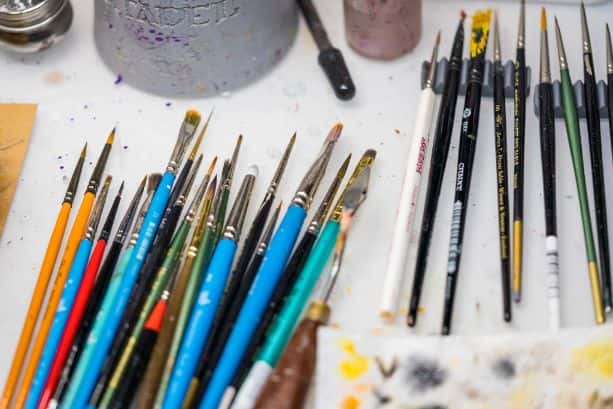
It is also a bit harder to clean a paintbrush after it has been loaded with metallic paints. I find the metal pigments get stuck or gum up the bristles more, especially when they get up close to the metal ferrule of the brush.
Do you need primer for metallic paint?
Absolutely, yes. Metallic paint really benefits from being applied to a black or very dark grey primer. You can get the same results with darker shades of grey, brown, etc., but I find that black primer works best for miniatures.
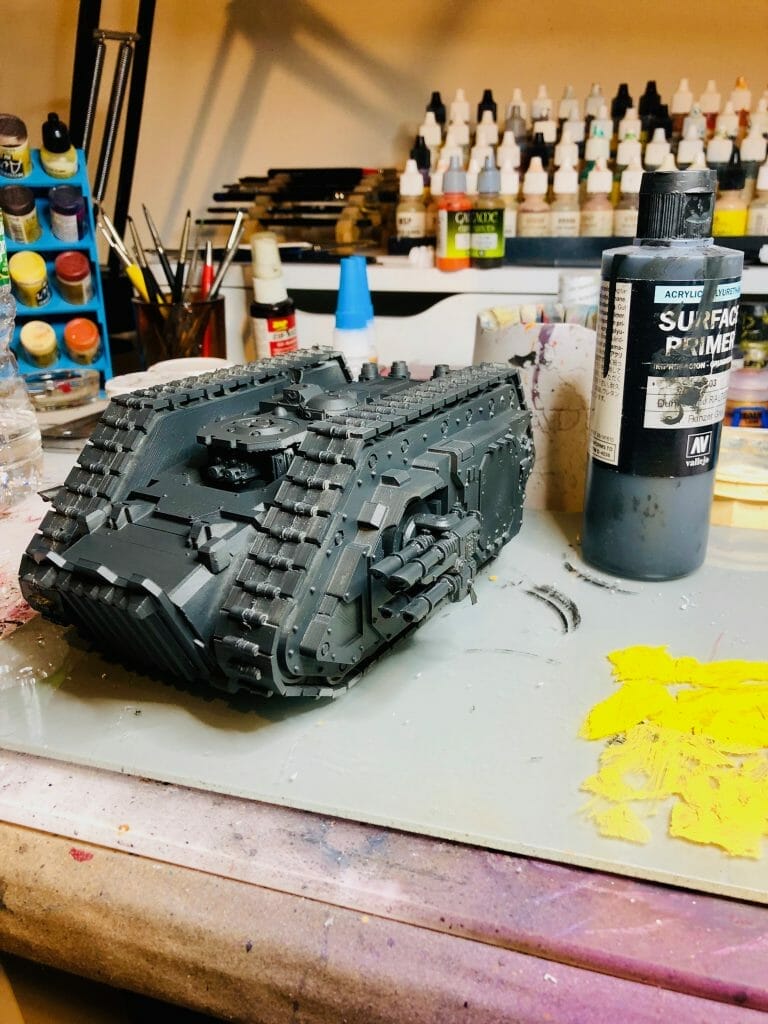
A quick easy tip to implement is that I’ve found that even when using a regular black primer, you can reduce the appearance of brushstrokes if you apply multiple thin coats of metallic paint instead of one thick coat. In general, my process is to apply the second coat of metallics using opposing a brush stroke direction–sweeping bristles the other way from the first layer.
How do you achieve the right tone when painting metallics?
The application of color theory with metallic paints is similar to the process you may use with any other type of paint for miniatures. It’s important to think about the tone of a metallic paint, and how it looks in comparison to its surroundings. Metallic paints reflect color easily, and even a slight shift in hue can create noticeable color variations.
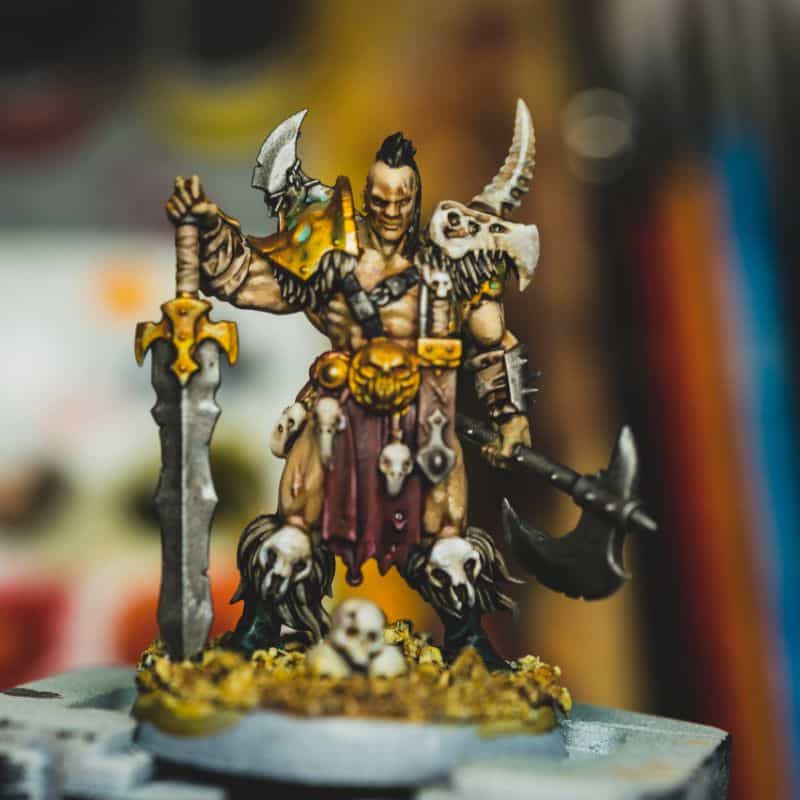
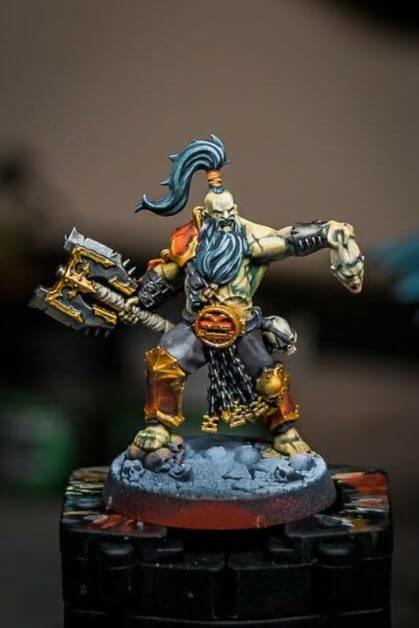
Learn how different colors work together, and always remember to keep contrast high if you’re looking to enhance the 3D volume of a miniature with paint and “make it pop”.
Conclusion
I hope you found this article helpful about ways to get great results with metallic paints! Metallic paints are fun to use and can give you great results that appear more realistic. The reflective quality of metallic model paint is a powerful tool in our hobby–and has been for a decades.
The advent of acrylic, water-based metallic paints has given us the ability to get professional looking results without having to resort to enamels, and smelly, harmful lacquers. With a bit of practice and patience, and some tips shown here,you can get that perfect “metallized” look on your miniatures.
Until next time! Happy metallics painting!
Check out my 5 favorite metallic paints and why I think these are all I need. Do you have a favorite brand of acrylic metallic paint? Let me know in the comments!

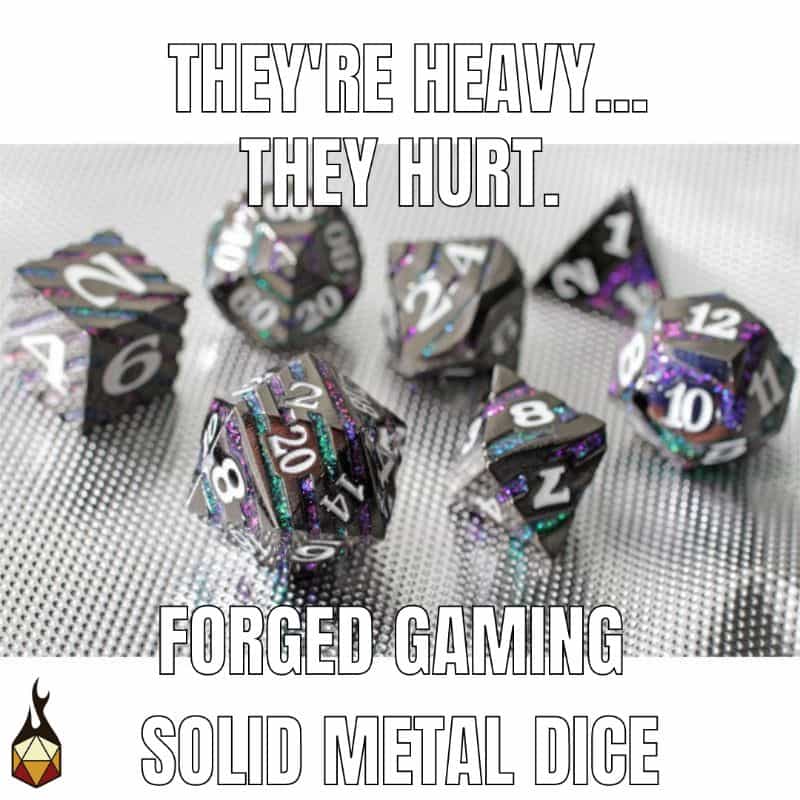


Tangible Day on YouTube (Miniatures and More!)

